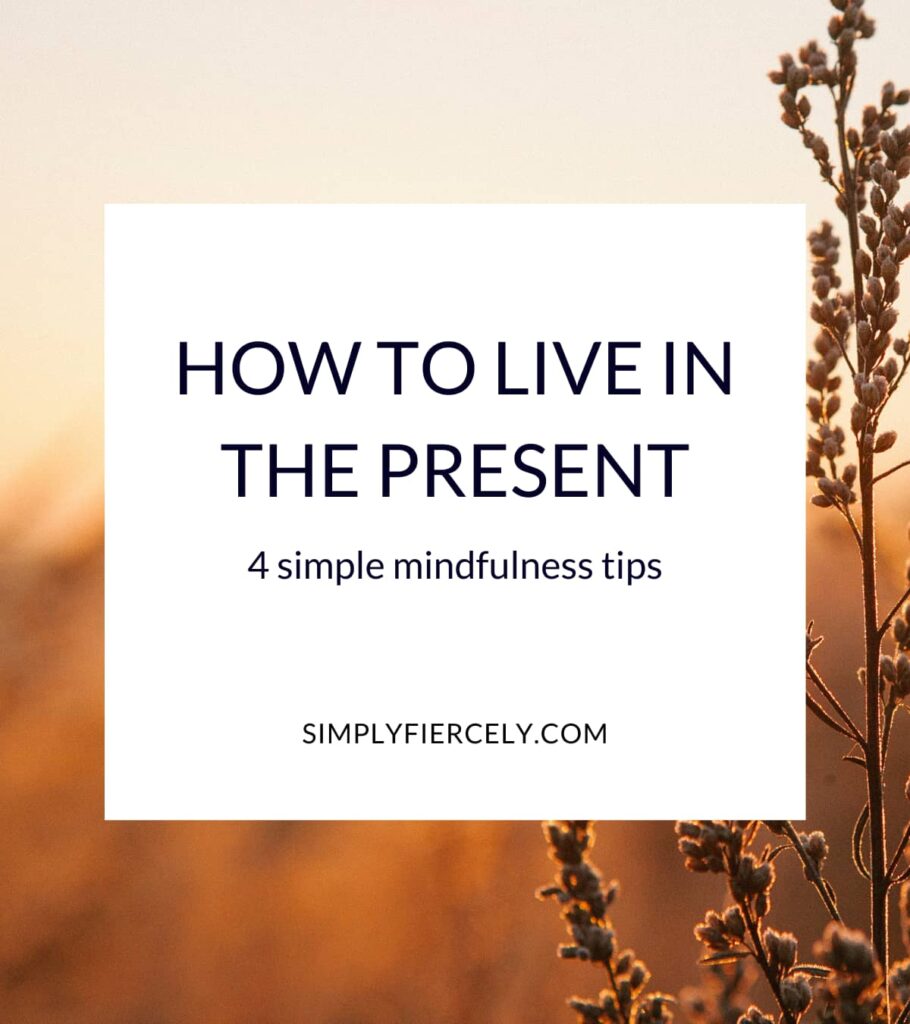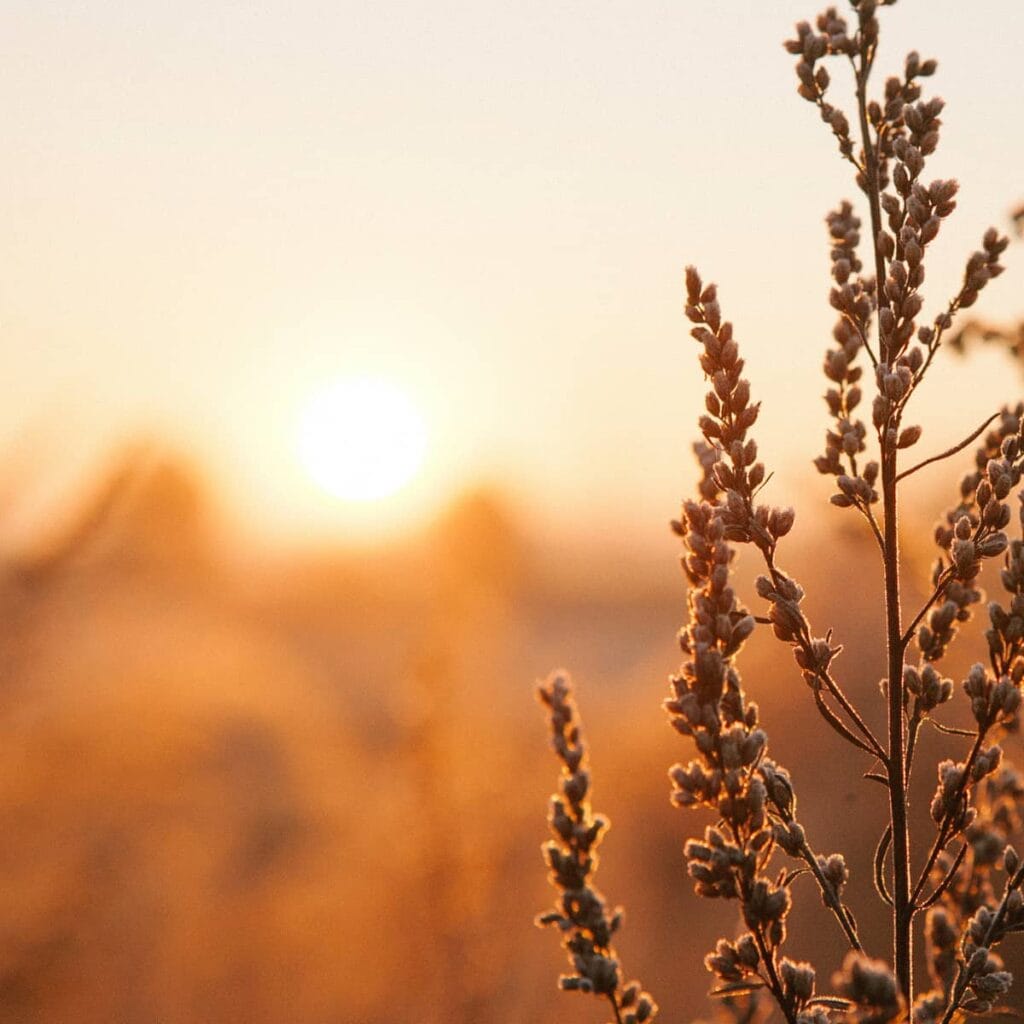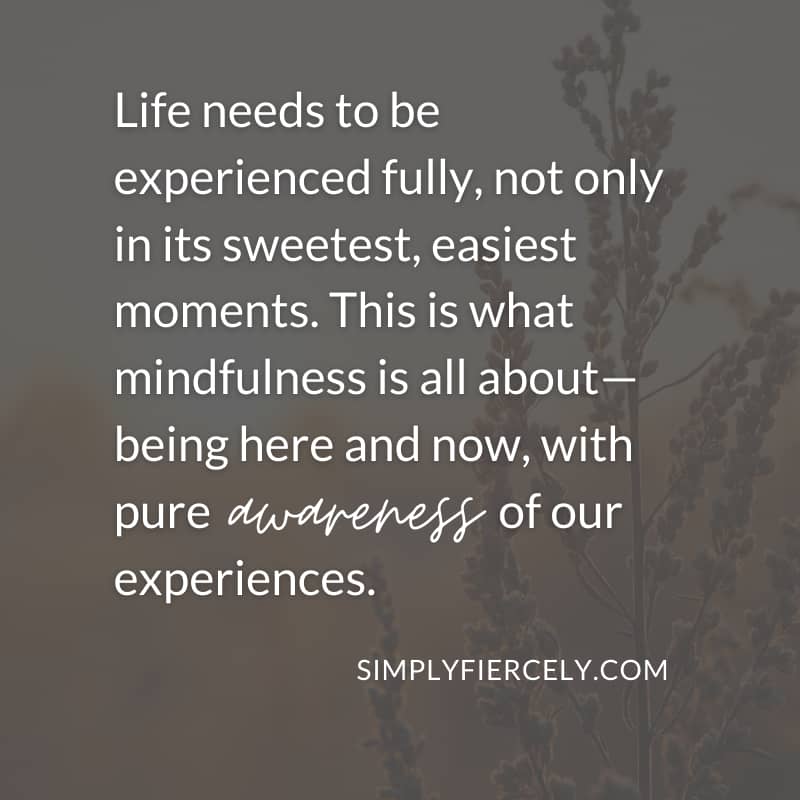Are you wondering how to live in the present? Here are four simple mindfulness tips that will help you be in the moment and live to the fullest.
With everything that 2020 has served us: wildfires, droughts, a global pandemic and an on-and-off lockdown—no wonder many of us feel a bit untethered.
Not wanting to accept reality for what it is (let’s call it escapism) can seem like an easy way out of stressful situations. But the truth is—it only works short-term. Life needs to be experienced fully, not only in its sweetest, easiest moments.
This is what mindfulness is all about—being here and now, with pure awareness of our experiences. It doesn’t mean you have to meditate for hours on end or join a Buddhist ashram. But it requires connecting with yourself and your habits. And the rewards, let me assure you, are aplenty.

This post contains affiliate links, which means I recommend products and make a small commission on purchases at no additional cost to you. Click here for the full disclosure statement.
The Struggle to Be In the Moment
Admittedly, being present and living in the moment is something I’ve always struggled with—it’s a side effect of being a daydreamer! As my friends will tell you, I’m always in the middle of making new plans.
It keeps life interesting, but it also means that sometimes I struggle to just be and enjoy this moment in time.
I often have a countdown—waiting for the weekend, for my next holiday, or for the summer to come—and it’s easy to get in the bad habit of wishing the days away.
I’m sure I’m not the only one who has given in to the “better tomorrow” syndrome, believing that life will be sweeter at some date in the future: once I get a new job, once I lose a few kilos, or once something new happens.
My overactive imagination can work in the opposite direction as well. Sometimes when I think about my future, instead of daydreaming about a better tomorrow, I find myself imagining the worst-case scenarios and inventing situations to worry about.
I’m capable of making things in my head look much worse than they really are. If you’ve ever spent a Sunday bummed out because you’re worried about what Monday morning has in store, then maybe you know what I mean?
In either case, the problem is my thoughts are robbing me of the joy of today. Nothing in the future is ever certain, but the truth is—I am in control of how I feel, right now, at this moment.
Do you always have a countdown too? Are you waiting to enjoy life or are you living in the present moment? If you fall into the first camp, here are a few practical ideas to help you start living in the moment and embrace the joys of today.
So let’s hold space for each other as we embark on this mindful journey together.

Why Is It Important To Be Present?
According to a 2010 Harvard University study, we spend about 47% of waking hours thinking about something other than what we’re doing, and this mind-wandering makes us unhappy.
We worry about overdue bills while playing with our kids. We obsess over a random comment made by our work colleague when out with friends. Often, we stress over things that never happened! Yet psychologists Matthew A. Killingsworth and Daniel T. Gilbert from Harvard University note: “True happiness is to be found by living in the moment.”
I like this quote from Buddha: “We shouldn’t mourn for the past, nor worry about the future, but live the present moment wisely and earnestly.” Because mindfulness is purposefully paying attention to things that happen to us.
When I’m making coffee in the morning, I don’t want to stress about the list of chores ahead. I don’t need to debate what I’m going to wear or say. I want to bathe in the glorious aroma of coffee and then drink it with pleasure.
By getting caught up in our heads, we miss many emotional connections with people around us. We dwell on the negative side of life, increasing the levels of stress hormones and literally—making our bodies sick.
It’s not entirely your fault if you’re guilty of doing this—NOT living in the moment. Evolution has created our monkey mind to help us survive imminent dangers. Today, in our fast-paced world full of external stimulation, it adds to a constant mental juggle. But the good thing is— you have the power to change it.
Related Post: How to Create a Culture of Slow Living
4 Practical Ways to Be Present Every Day
If my story resonates with you, then here are four mindfulness tips that will help you get out of your head and into the present moment.
GET PHYSICAL
Often, when I find myself caught up in my head, the best way to break free is to find ways to physically connect myself to the present moment and the environment around me.
Focusing on my sense of touch pulls me out of my mind, helps me let go of thoughts, and allows me to simply be in a quiet moment. Science proves that grounding—so getting in touch with the Earth’s natural electric charge—balances out our physiology, reducing stress, pain, improving blood flow, energy and sleep.
Here are a few simple physical activities to try:
- Take off your shoes and walk barefoot on grass or a sandy beach
- Press your palms and rub them together creating a warm sensation
- Sip on a hot/cold drink
- Get a massage (or simply rub your temples, you can add a drop of your favourite essential oil to make it more sensual)
- Take a few, deep belly breaths – concentrating on filling your abdomen area with air and then breathing out through pursed lips with a whistle.
During your chosen grounding activity, close your eyes, focus on the feeling of your skin and your muscles, the weight of your body, the smells and sounds around you. And then take a few deep breaths. Breathing helps to promote relaxation, stress reduction and better body awareness.
I find this tip especially useful when I’m worrying about the future. By focusing on my body, I am reminded that right now, at this moment, I’m here, safe and everything is ok.
TRY A MEDITATION APP
I know a lot of people are sceptical about meditation (and for a long time I was too!). There are a lot of preconceptions about what meditation is, and it can feel really strange or even intimidating at first—plus it’s difficult to know where to start!
But meditation can be a wonderful—and free—way of practising self-care. Scientists rave about its benefit to the body and mind. It seems to reduce the neural density in the amygdala section of the brain (that’s the infamous monkey mind!), which—in effect—calms us, grounds us, and makes us more creative, happy and light.
If you’re still slightly apprehensive or don’t know where to start, I highly suggest downloading a meditation app. I started learning about meditation by using the Headspace app. “If we can learn how to apply focus moment-to-moment, then we’ll see that play out in our longer-term goals,” says Headspace co-founder Andy Puddicombe.
Their free course includes a selection of 10-minute guided meditations, and it’s here I learned that meditation isn’t about stopping your thoughts. Instead, it is about graciously acknowledging them and then letting them go.
Although I’m still working on establishing a regular meditation routine, I’ve already noticed a distinct change in my thinking. After meditating, I feel like I’ve completely emptied my brain, and I have a clean slate, ready to be filled by new thoughts of my own choosing.

FIND TIME TO DO SOMETHING YOU LOVE
Have you ever lost track of time? It happens when you’re doing something you really enjoy—you get in the ‘zone’, and you lose focus on everything but the task in front of you.
In other words, your attention is devoted to what you’re doing now instead of somewhere in the past or future. You’re in a state of flow. There is a sense of fluidity between your body and mind. Time feels like it has slowed down.
The Japanese call it ikigai —translated as ‘a reason for being’ or ‘a sense of purpose’ (iki means ‘life’ and kai ‘being worthwhile’). In a nutshell, it’s a way of living well because one has something exciting to get up to every day. There are strong scientific proofs that a happy lifestyle and well-being are connected.
So next time you find yourself distracted and unable to focus, instead of trying to force yourself into the present moment, ease yourself there by doing something that brings you joy.
Do you know what sets you on fire and lets you lose yourself in the zone? Lately, for me, it’s working on this blog—I find the creative writing process so therapeutic! Maybe for you, it’s baking, dancing, or perhaps painting?
Even if you’re busy, try and find a little bit of time to do something that you love, and you’ll quiet any mental chatter you’re experiencing.
KEEP A RECORD
Writing—or as it is now fancily called: journaling—is a great way to keep your rushing thoughts at bay. Psychologist Deborah Smith, the author of Grow Your Own Happiness, says that it’s a beautiful way to tap into your own inner mind. And she’s right!
There’s plenty of scientific evidence that journaling has amazing benefits for our health. When we write, we access our left, analytical brain, allowing our right brain to be free to create, intuit and feel. That’s why it always feels so liberating to scribble down a few thoughts or pen a letter.
One thing I liked to do is keep a simple scrapbook—nothing fancy, just a few momentos or scribbles about how I spend each day. What I noticed is that keeping a record of my daily activities helps me to be mindful and take notice of the little joys in life. Instead of mindlessly going through my day (or worse—scrolling down on my phone), I’m actively seeking to remember it so that I can record it later.
I now use my journal religiously and try to keep a little log of my daily activities. It doesn’t have to be epic adventures; the small things, like an evening walk with my husband or taking a few minutes to finish a difficult task, are worth recording and remembering.
New to journaling? Try these journaling ideas or these simple journal prompts.
More Mindfulness Resources
If you’d like to learn more, here are several resources about mindful living that I think you’ll enjoy.
BOOKS
- The Power of Now by Eckhart Tolle: “As soon as you honour the present moment, all unhappiness and struggle dissolve, and life begins to flow with joy and ease.”
- Wherever You Go, There You Are: Mindfulness Meditation in Everyday Life by Jon Kabat-Zinn: “Like it or not, this moment is all we really have to work with.”
- Slow. Live Life Simply by Brooke McAlary: “Be a curator of your life.”
PODCASTS & TALKS
- “The Art of Stillness”, TED Talk by travel writer Pico Iyer:
- “Why It Is So Hard to Live in the Present”, a short video by philosopher Alain de Botton from the School of Life
- ”Oprah’s SuperSoul Conversations” Podcast
- “The Calmer You Podcast” with Chloe Brotheridge
Do you struggle with being present? Or do you have any tips about how to live in the moment that you think I should add to my list? I’d love to hear your thoughts—please let me know in the comments! x


Love this article! ❤️